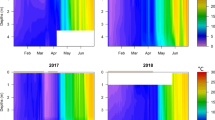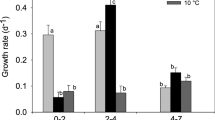Abstract
Plankton succession during spring/early summer in temperate lakes is characterised by a highly predictable pattern: a phytoplankton bloom is grazed down by zooplankton (Daphnia) inducing a clear-water phase. This sequence of events is commonly understood as a cycle of consumer-resource dynamics, i.e. zooplankton growth is driven by food availability. Here we suggest, using a modelling study based on a size-structured Daphnia population model, that temperature and not food is the dominant factor driving interannual variability of Daphnia population dynamics during spring. Simply forcing this model with a seasonal temperature regime typical for temperate lakes is sufficient for generating the distinctive seasonal trajectory of Daphnia abundances observed in meso-eutrophic temperate lakes. According to a scenario analysis, a forward shift of the vernal temperature increase by 60 days will advance the timing of the Daphnia maximum on average by 54 days, while a forward shift in the start of the spring bloom by 60 days will advance the Daphnia maximum only by less than a third (17 days). Hence, the timing of temperature increase was more important for the timing of Daphnia development than the timing of the onset of algal growth. The effect of temperature is also large compared to the effect of applying different Daphnia mortality rates (0.055 or 0.1 day−1, 38 days), an almost tenfold variation in phytoplankton carrying capacity (25 days) and a tenfold variation in Daphnia overwintering abundance (3 days). However, the standing stock of Daphnia at its peak was almost exclusively controlled by the phytoplankton carrying capacity of the habitat and seems to be essentially independent of temperature. Hence, whereas food availability determines the standing stock of Daphnia at its spring maximum, temperature appears to be the most important factor driving the timing of the Daphnia maximum and the clear-water phase in spring.






Similar content being viewed by others
References
Adrian R, Deneke R (1996) Possible impact of mild winters on zooplankton succession in eutrophic lakes of the Atlantic European area. Freshwater Biol 36:757–770
Adrian R, Walz N, Hintze T, Hoeg S, Rusche R (1999) Effects of ice duration on plankton succession during spring in a shallow polymictic lake. Freshwater Biol 41:621–632
Anneville O, Souissi S, Ibanez F, Ginot V, Druart JC, Angeli N (2002) Temporal mapping of phytoplankton assemblages in Lake Geneva: annual and interannual changes in their patterns of succession. Limnol Oceanogr 47:1355–1366
Benndorf J, Kranich J, Mehner T, Wagner A (2001) Temperature impact on the midsummer decline of Daphnia galeata: an analysis of long-term data from the biomanipulated Bautzen Reservoir (Germany). Freshwater Biol 46:199–211
Berger SA, Diehl S, Kunz TJ, Albrecht D, Oucible AM, Ritzer S (2006) Light supply, plankton biomass, and seston stoichiometry in a gradient of lake mixing depths. Limnol Oceanogr 51:1898–1905
Berger SA, et al (2007) Water temperature and mixing depth affect timing and magnitude of events during spring succession of the plankton. Oecologia 150:643–654
Bleiker W, Schanz F (1997) Light climate as the key factor controlling the spring dynamics of phytoplankton in Lake Zurich. Aquat Sci 59:135–157
De Roos AM (1997) A gentle introduction to physiologically structured population models. In: Tuljapurkar S, Caswell H (eds) Structured-population models in marine, terrestrial and freshwater systems. Chapman & Hall, New York, pp 119–204
De Roos AM, Persson L (2001) Physiologically structured models—from versatile technique to ecological theory. Oikos 94:51–71
De Roos AM, Diekmann O, Metz JAJ (1992) Studying the dynamics of structured population models: a versatile technique and its application to Daphnia. Am Nat 139:123–147
De Senerpont Domis LN, Mooij WM, Hülsmann S, Van Nes EH, Scheffer M (2007) Can overwintering versus diapausing strategy in Daphnia determine match-mismatch events in zooplankton-algae interactions? Oecologia 150(4):682–698
George DG, Maberly SC, Hewitt DP (2004) The influence of the North Atlantic oscillation on the physical, chemical and biological characteristics of four lakes in the English Lake District. Freshwater Biol 49:760–774
Gerten D, Adrian R (2000) Climate-driven changes in spring plankton dynamics and the sensitivity of shallow polymictic lakes to the North Atlantic oscillation. Limnol Oceanogr 45:1058–1066
Gilloly JF, Dodson SI (2000) Latitudinal patterns in the size distribution and seasonal dynamics of new world, freshwater cladocerans. Limnol Oceanogr 45:22–30
Gliwicz ZM, Slusarczyk A, Slusarczyk M (2001) Life history synchronization in a long-lifespan single-cohort Daphnia population in a fishless alpine lake. Oecologia 128:368–378
Hall DJ (1964) An experimental approach to the dynamics of a natural population of Daphnia galeata mendotae. Ecology 45:94–112
Horn H, Paul L (1984) Interactions between light situation, depth of mixing and phytoplankton growth during the spring period of full circulation. Int Rev Ges Hydrobiol 69:507–519
Hülsmann S (2000) Population dynamics of Daphnia galeata in the biomanipulated Bautzen Reservoir: life history strategies against food deficiency and predation. Ph.D. thesis, TU Dresden, Dresden
Hülsmann S, Weiler W (2000) Adult, not juvenile mortality as a major reason for the midsummer decline of a Daphnia population. J Plankton Res 22:151–168
IPCC (2001) Climate change 2001: synthesis report. A contribution of Working Groups I, II, and III to the third assessment report of the Integovernmental Panel on Climate Change. In: Watson RT, the Core Writing Team (eds) Cambridge University Press, Cambridge
Kooijman SALM (2000) Dynamic energy and mass budgets in biological systems. Cambridge University Press, Cambridge
Kooijman SALM (2001) Quantitative aspects of metabolic organization: a discussion of concepts. Philos Trans R Soc B 356:331–349
Lampert W (1978) Climatic conditions and planctonic interactions as factors controlling the regular succession of spring algal bloom and extremely clear water in Lake Constance. Verh Int Ver Theor Angew Limnol 20:969–974
Lampert W, Fleckner W, Rai H, Taylor BE (1986) Phytoplankton control by grazing zooplankton: a study on the spring clear-water phase. Limnol Oceanogr 31:478–490
Lynch M (1980) The evolution of cladoceran life histories. Q Rev Biol 55:23–42
Peeters F, Straile D, Lorke A, Ollinger D (2007a) Turbulent mixing and phytoplankton spring bloom development in a deep lake. Limnol Oceanogr 52:286–298
Peeters F, Straile D, Lorke A, Livingstone DM (2007b) Earlier onset of the spring phytoplankton bloom in lakes of the temperate zone in a warmer climate. Glob Change Biol 13:1898–1909
Reynolds CS (1992) Dynamics, selection and composition of phytoplankton in relation to vertical structures in lakes. Arch Hydrobiol Beih Ergeb Limnol 35:13–31
Rinke K, Petzoldt T (2003) Modelling the effects of temperature and food on individual growth and reproduction of Daphnia and their consequences on the population level. Limnologica 33:293–304
Rinke K, Vijverberg J (2005) A model approach to evaluate the effect of temperature and food concentration on individual life history and population dynamics of Daphnia. Ecol Model 186:326–344
Romare P, Schindler DE, Scheurell MD, Scheurell J, Litt AH, Shepherd JH (2005) Variation in spatial and temporal gradients in zooplankton spring development: the effect of climatic factors. Freshwater Biol 50:1007–1021
Scheffer M, Rinaldi S, Kuznetsov YA, van Nes EH (1997) Seasonal dynamics of Daphnia and algae explained as a periodically forced predator-prey system. Oikos 80:519–532
Scheffer M, Straile D, van Nes EH, Hosper H (2001) Climatic warming causes regime shifts in lake foodwebs. Limnol Oceanogr 46:1780–1783
Slobodkin LB (1954) Population dynamics in Daphnia obtusa Kurz. Ecol Monogr 24:69–88
Sommer U, Gliwicz ZM, Lampert W, Duncan A (1986) The PEG-model of seasonal succession of planktonic events in fresh waters. Arch Hydrobiol 106:433–471
Straile D (2000) Meteorological forcing of plankton dynamics in a large and deep continental European lake. Oecologia 122:44–50
Straile D (2002) North Atlantic Oscillation synchronises food web interactions in central european lakes. Proc R Soc Lond B Biol 269:391–395
Straile D, Adrian R (2000) The North Atlantic oscillation and plankton dynamics in two European lakes—two variations on a general theme. Glob Change Biol 6:663–670
Straile D, Johnk K, Rossknecht H (2003) Complex effects of winter warming on the physicochemical characteristics of a deep lake. Limnol Oceanogr 48:1432–1438
Vandekerkhove J, Declerck S, Brendonck L, Conde-Porcuna JM, Jeppesen E, De Meester L (2005) Hatching of cladoceran resting eggs: temperature and photoperiod. Freshwater Biol 50:96–104
Weisse T, Muller H, Pintocoelho RM, Schweizer A, Springmann D, Baldringer G (1990) Response of the microbial loop to the phytoplankton spring bloom in a large prealpine lake. Limnol Oceanogr 35:781–794
Winder M, Schindler DE (2004) Climate change uncouples trophic interactions in an aquatic ecosystem. Ecology 85:2100–2106
Acknowledgements
This research has been supported by the Deutsche Forschungsgemeinschaft (within the AQUASHIFT priority program 1162, Pe 701/2-1). K. Rinke was partly funded by the Deutsche Forschungsgemeinschaft (under grant Ro 1008/11-1). Two anonymous reviewers and S. Diehl made helpful suggestions to improve the manuscript.
Author information
Authors and Affiliations
Corresponding author
Additional information
Communicated by Ulrich Sommer.
Electronic supplementary material
Below is the link to the electronic supplementary material.
Rights and permissions
About this article
Cite this article
Schalau, K., Rinke, K., Straile, D. et al. Temperature is the key factor explaining interannual variability of Daphnia development in spring: a modelling study. Oecologia 157, 531–543 (2008). https://doi.org/10.1007/s00442-008-1081-3
Received:
Accepted:
Published:
Issue Date:
DOI: https://doi.org/10.1007/s00442-008-1081-3




